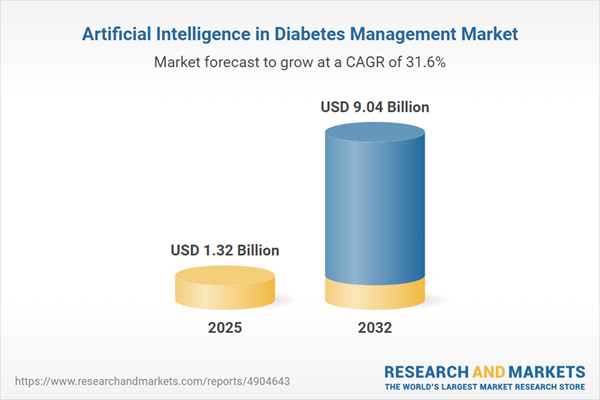Speak directly to the analyst to clarify any post sales queries you may have.
Artificial intelligence in diabetes management is reshaping healthcare delivery, offering organizations a pathway to enhance digital health infrastructure, optimize operational efficiency, and improve patient outcomes. Executive leaders are leveraging AI-driven insights and integrated digital platforms to address rising demand for proactive, coordinated chronic disease care.
Market Snapshot: Artificial Intelligence in Diabetes Management
In 2024, the artificial intelligence in diabetes management market attains a value of USD 1 billion, supported by a robust 31.57% compound annual growth rate. Healthcare leaders are accelerating adoption of advanced machine learning and secure cloud-based solutions, creating agile, data-focused care environments. Sophisticated digital infrastructure and continuous patient monitoring are enabling healthcare organizations to refine workflows, ensure seamless care coordination, and promote timely information exchange across teams. As regulatory expectations evolve and continuous care gains priority, these digital capabilities are essential to meeting the sector’s demands.
Scope & Segmentation: Comprehensive Market Breakdown
- Device Types: Integration spans standard blood glucose meters, continuous glucose monitoring systems, and a variety of insulin pumps including patch, tubed, and closed-loop models, facilitating tailored care delivery across diverse patient profiles.
- Technology Enablers: The market is driven by cloud-based solutions, machine learning-powered decision support systems, predictive analytics, and mobile applications. These technological foundations are central to connecting providers with actionable patient data and supporting self-management strategies.
- End Users: Tools are designed for specialty diabetes centers, general clinics, hospitals, research entities, and home healthcare teams. Segment-specific customization ensures all care delivery settings can achieve efficient, high-quality patient management.
- Deployment Models: Organizations can select from public cloud, private cloud, hybrid deployments, or on-premise installations, which offers flexibility in meeting local IT, risk management, and privacy demands.
- Diabetes Types: Solutions address gestational diabetes, all stages of type 1 diabetes, and the full range of type 2 diabetes, providing scalable management options aligned with varying patient group requirements and supporting wider population health initiatives.
- Core Components: Wearable biosensors, digital monitoring devices, and secure software applications enable seamless integration of clinical data and operational workflows while maintaining high levels of data privacy.
- Geographic Coverage: The market encompasses the Americas, Europe, Middle East and Africa, and Asia-Pacific regions. Adoption is led by key markets such as the United States, Germany, China, India, and Brazil, with implementation priorities guided by local policy, regulatory frameworks, and regional innovation.
- Featured Companies: Industry participants include Medtronic plc, Abbott Laboratories, Dexcom Inc., F. Hoffmann-La Roche Ltd, Insulet Corporation, Tandem Diabetes Care Inc., Teladoc Health Inc., Omada Health Inc., Bigfoot Biomedical Inc., and Glooko Inc., all advancing AI-enabled diabetes management solutions.
Key Takeaways for Senior Decision-Makers
- Artificial intelligence in diabetes management empowers real-time risk detection, alerting clinicians to potential complications and supporting prompt, preventative interventions.
- Integrating diverse data sources across operational and clinical systems fosters improved collaboration and transparency, streamlining care delivery across multidisciplinary teams.
- Flexible deployment options allow healthcare organizations to align technology infrastructure with evolving compliance, privacy, and regulatory requirements while pursuing ongoing digital modernization.
- Strategic partnerships between healthcare providers and technology vendors are instrumental in ensuring effective digital transformation and maximizing solution impact throughout care networks.
- Machine learning-driven analytics enable the design of agile, personalized intervention and prevention plans tailored to organizational and patient needs.
Tariff Impact: U.S. Trade Policy and Market Strategy
Recent U.S. tariffs on medical and digital health technology imports are prompting healthcare organizations to reevaluate sourcing strategies. By emphasizing domestic supply chains and hybrid or on-premise digital infrastructure, organizations gain greater regulatory flexibility and resilience. This approach helps stabilize costs, support compliance obligations, and safeguard ongoing technology implementation.
Methodology & Data Sources
The findings in this report are based on direct input from clinicians, digital health executives, and regulatory experts active in the diabetes care domain. Data are independently validated and supplemented by reliable market intelligence, ensuring informed strategic planning for industry stakeholders.
Why This Report Matters
- Supports senior leadership with a practical blueprint for adopting artificial intelligence in diabetes management, guiding decision-making from initial strategy through implementation.
- Delivers comprehensive segmentation and regulatory analysis, informing risk management and supporting market entry or expansion efforts.
- Offers a forward-looking perspective on digital health adoption, helping leaders anticipate emerging trends and maintain a competitive market stance.
Conclusion
Investing in artificial intelligence within diabetes management enables organizations to establish secure, integrated, and scalable care processes, positioning them for continued innovation and resilience within the evolving global digital health landscape.
Additional Product Information:
- Purchase of this report includes 1 year online access with quarterly updates.
- This report can be updated on request. Please contact our Customer Experience team using the Ask a Question widget on our website.
Table of Contents
3. Executive Summary
4. Market Overview
7. Cumulative Impact of Artificial Intelligence 2025
Companies Mentioned
The companies profiled in this Artificial Intelligence in Diabetes Management market report include:- Medtronic plc
- Abbott Laboratories
- Dexcom, Inc.
- F. Hoffmann-La Roche Ltd
- Insulet Corporation
- Tandem Diabetes Care, Inc.
- Teladoc Health, Inc.
- Omada Health, Inc.
- Bigfoot Biomedical, Inc.
- Glooko Inc.
Table Information
| Report Attribute | Details |
|---|---|
| No. of Pages | 183 |
| Published | October 2025 |
| Forecast Period | 2025 - 2032 |
| Estimated Market Value ( USD | $ 1.32 Billion |
| Forecasted Market Value ( USD | $ 9.04 Billion |
| Compound Annual Growth Rate | 31.5% |
| Regions Covered | Global |
| No. of Companies Mentioned | 11 |









